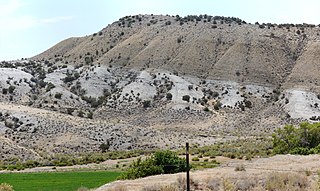The Cenomanian is, in the International Commission on Stratigraphy's (ICS) geological timescale, the oldest or earliest age of the Late Cretaceous Epoch or the lowest stage of the Upper Cretaceous Series. An age is a unit of geochronology; it is a unit of time; the stage is a unit in the stratigraphic column deposited during the corresponding age. Both age and stage bear the same name.

The Turonian is, in the ICS' geologic timescale, the second age in the Late Cretaceous Epoch, or a stage in the Upper Cretaceous Series. It spans the time between 93.9 ± 0.8 Ma and 89.8 ± 1 Ma. The Turonian is preceded by the Cenomanian Stage and underlies the Coniacian Stage.

Inoceramus is an extinct genus of fossil marine pteriomorphian bivalves that superficially resembled the related winged pearly oysters of the extant genus Pteria. They lived from the Early Jurassic to latest Cretaceous.
Kamerunoceras is an extinct cephalopod genus belonging to the ammonite family Acanthoceratidae, found in Upper Cretaceous formations of Africa, Europe and North and South America.

The Pierre Shale is a geologic formation or series in the Upper Cretaceous which occurs east of the Rocky Mountains in the Great Plains, from Pembina Valley in Canada to New Mexico.

Placenticeras is a genus of ammonites from the Late Cretaceous. Its fossils have been found in Asia, Europe, North and South America.

The Kaskapau Formation is a geological formation in North America whose strata date back to the Late Cretaceous.

Sphenodiscus is an extinct genus of acanthoceratacean ammonite. The genus has been found from many continents and is thought to have had a large global distribution during the Maastrichtian stage of the Late Cretaceous. It was one of the last ammonoids to have evolved before the entire subclass became extinct during the Paleocene, which was directly after the Cretaceous–Paleogene extinction event.

The Tres Hermanos Formation is a geologic formation in central and west-central New Mexico. It contains fossils characteristic of the Turonian Age of the late Cretaceous.

The Menefee Formation is an upper Santonian to lower Campanian geologic formation found in Colorado and New Mexico, United States.

The Mowry Shale is an Early Cretaceous geologic formation. The formation was named for Mowrie Creek, northwest of Buffalo in Johnson County, Wyoming.

The Straight Cliffs Formation is a stratigraphic unit in the Kaiparowits Plateau of south central Utah. It is Late Cretaceous in age and contains fluvial, paralic, and marginal marine (shoreline) siliciclastic strata. It is well exposed around the margin of the Kaiparowits Plateau in the Grand Staircase – Escalante National Monument in south central Utah. The formation is named after the Straight Cliffs, a long band of cliffs creating the topographic feature Fiftymile Mountain.

The Carlile Shale is a Turonian age Upper/Late Cretaceous series shale geologic formation in the central-western United States, including in the Great Plains region of Colorado, Kansas, Nebraska, New Mexico, North Dakota, South Dakota, and Wyoming.

Collignociceras is a strongly ribbed and tuberculate, evolute ammonite from the Turonian of the western U.S. and Europe belonging to the ammonitid family Collignoniceratidae. The genus is named after the French paleontologist Maurice Collignon. The type is Collignoniceras woollgari, named by Mantell in 1822 for specimens from Sussex, England.
Neoptychites is an extinct ammonoid cephalopod genus from the Turonian stage of the Upper Cretaceous, with a worldwide distribution.

Collignoniceratidae is a family of Upper Cretaceous ammonites characterized by typically more or less evolute shells with compressed, oval, or square whorl sections; serrate or entire keels; and dense ribs with one to 5 tubercles.

Mammites is a Late Cretaceous ammonite genus included in the acanthoceratoidean family, Acanthoceratidae, and the type genus for the subfamily Mammitinae. Mammites was named by Laube and Bruder in 1887.

The Acanthoceratinae comprise a subfamily of ammonoid cephalopods that lived during the Late Cretaceous from the latter early Cenomanian to the late Turonian
Cunningtoniceras is a stocky acanthoceratid ammonite from the upper Cenomanian stage of the late Cretaceous of the western U.S., found e.g. in Arizona and New Mexico.
Neocardioceras is a genus of evolute acanthoceratid ammonites from the uppermost Cenomanian, Upper Cretaceous, of Europe, western U.S. and Brazil.














